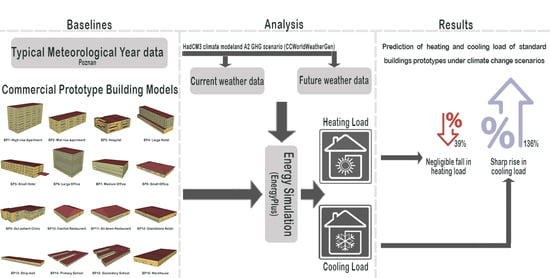The Impact Assessment of Climate Change on Building Energy Consumption in Poland
Abstract
:1. Introduction
2. Literature Review
2.1. Projecting Energy Consumption of Buildings
2.2. Weather Data
2.3. Climate Models and Projection
3. Methodology
4. Results
5. Discussion
6. Conclusions
Author Contributions
Funding
Institutional Review Board Statement
Informed Consent Statement
Data Availability Statement
Conflicts of Interest
References
- Moazami, A.; Nik, V.M.; Carlucci, S.; Geving, S. Impacts of future weather data typology on building energy performance—Investigating long-term patterns of climate change and extreme weather conditions. Appl. Energy 2019, 238, 696–720. [Google Scholar] [CrossRef]
- IPCC. Synthesis Report Contribution of Working Groups I, II and III to the Fifth Assessment Report of the Intergovernmental Panel on Climate Change; IPCC: Geneva, Switzerland, 2014. [Google Scholar]
- Berardi, U.; Jafarpur, P. Assessing the impact of climate change on building heating and cooling energy demand in Canada. Renew. Sustain. Energy Rev. 2020, 121, 109681. [Google Scholar] [CrossRef]
- Madlener, R.; Sunak, Y. Impacts of urbanization on urban structures and energy demand: What can we learn for urban energy planning and urbanization management? Sustain. Cities Soc. 2011, 1, 45–53. [Google Scholar] [CrossRef]
- Cao, X.; Dai, X.; Liu, J. Building energy-consumption status worldwide and the state-of-the-art technologies for zero-energy buildings during the past decade. Energy Build. 2016, 128, 198–213. [Google Scholar] [CrossRef]
- Bazazzadeh, H.; Nadolny, A.; Hashemi Safaei, S.S. Climate Change and Building Energy Consumption: A Review of the Impact of Weather Parameters Influenced by Climate Change on Household Heating and Cooling Demands of Buildings. Eur. J. Sustain. Dev. 2021, 10, 1. [Google Scholar] [CrossRef]
- IEA. Tracking Buildings 2020; IEA: Paris, France, 2020. [Google Scholar]
- Tabrizikahou, A.; Nowotarski, P. Mitigating the Energy Consumption and the Carbon Emission in the Building Structures by Optimization of the Construction Processes. Energies 2021, 14, 3287. [Google Scholar] [CrossRef]
- Mancini, F.; Lo Basso, G. How Climate Change Affects the Building Energy Consumptions Due to Cooling, Heating, and Electricity Demands of Italian Residential Sector. Energies 2020, 13, 410. [Google Scholar] [CrossRef] [Green Version]
- Yau, Y.H.; Hasbi, S. A review of climate change impacts on commercial buildings and their technical services in the tropics. Renew. Sustain. Energy Rev. 2013, 18, 430–441. [Google Scholar] [CrossRef]
- Kheiri, F. A review on optimization methods applied in energy-efficient building geometry and envelope design. Renew. Sustain. Energy Rev. 2018, 92, 897–920. [Google Scholar] [CrossRef]
- Gero, J.S.; D’Cruz, N.; Radford, A.D. Energy in context: A multicriteria model for building design. Build. Environ. 1983, 18, 99–107. [Google Scholar] [CrossRef]
- European Commission (EC). Energy Consumption of Buildings per m²; European Commission, 2013. Available online: https://ec.europa.eu/energy/content/energy-consumption-m%C2%B2-2_en (accessed on 30 May 2021).
- Stuggins, G.; Sharabaroff, A.; Semikolenova, Y. Energy Efficiency; Lessons Learned from Success Stories; The World Bank: Washington, DC, USA, 2013. [Google Scholar] [CrossRef]
- IEA. Energy Policies of IEA Countries: Poland 2016 Review; IEA: Paris, France, 2017. [Google Scholar]
- Staniaszek, D.; Firląg, S. Financing Building Energy Performance Improvement in Poland; BPIE: Brussels, Belgium, 2016. [Google Scholar]
- BuildDeskPolska. Energy Condition of Buildings in Poland; BuildDeskPolska: Cigacice, Poland, 2011. [Google Scholar]
- Parysek, J.J.; Mierzejewska, L. Poznań. Cities 2006, 23, 291–305. [Google Scholar] [CrossRef]
- BuildDeskPolska. BuildDesk Analytics Report; Energy Condition of Buildings in Poland; BuildDeskPolska: Cigacice, Poland, 2019. [Google Scholar]
- European Union (EU). Energy Island Communities for Energy Transition. Available online: https://cordis.europa.eu/project/id/957845/pl (accessed on 17 February 2021).
- Seyedzadeh, S.; Pour Rahimian, F.; Oliver, S.; Rodriguez, S.; Glesk, I. Machine learning modelling for predicting non-domestic buildings energy performance: A model to support deep energy retrofit decision-making. Appl. Energy 2020, 279, 115908. [Google Scholar] [CrossRef]
- Eslamirad, N.; Malekpour Kolbadinejad, S.; Mahdavinejad, M.; Mehranrad, M. Thermal comfort prediction by applying supervised machine learning in green sidewalks of Tehran. Smart Sustain. Built Environ. 2020, 9, 361–374. [Google Scholar] [CrossRef]
- Ghaffour, W.; Ouissi, M.N.; Velay Dabat, M.A. Analysis of urban thermal environments based on the perception and simulation of the microclimate in the historic city of Tlemcen. Smart Sustain. Built Environ. 2021, 10, 141–168. [Google Scholar] [CrossRef]
- Thanu, H.P.; Rajasekaran, C.; Deepak, M.D. Developing a building performance score model for assessing the sustainability of buildings. Smart Sustain. Built Environ. 2020. ahead-of-print. [Google Scholar] [CrossRef]
- Rahmouni, S.; Smail, R. A design approach towards sustainable buildings in Algeria. Smart Sustain. Built Environ. 2020, 9, 229–245. [Google Scholar] [CrossRef]
- Dell’Anna, F.; Bottero, M.; Becchio, C.; Corgnati, S.P.; Mondini, G. Designing a decision support system to evaluate the environmental and extra-economic performances of a nearly zero-energy building. Smart Sustain. Built Environ. 2020, 9, 413–442. [Google Scholar] [CrossRef]
- Seyedzadeh, S.; Pour Rahimian, F. Building Energy Data-Driven Model Improved by Multi-objective Optimisation. In Data-Driven Modelling of Non-Domestic Buildings Energy Performance: Supporting Building Retrofit Planning; Seyedzadeh, S., Pour Rahimian, F., Eds.; Springer International Publishing: Cham, The Netherlands, 2021; pp. 99–109. [Google Scholar] [CrossRef]
- Weiss, T. Energy flexibility and shiftable heating power of building components and technologies. Smart Sustain. Built Environ. 2020. ahead-of-print. [Google Scholar] [CrossRef]
- Sheikhkhoshkar, M.; Pour Rahimian, F.; Kaveh, M.H.; Hosseini, M.R.; Edwards, D.J. Automated planning of concrete joint layouts with 4D-BIM. Autom. Constr. 2019, 107, 102943. [Google Scholar] [CrossRef]
- Kottek, M.; Grieser, J.; Beck, C.; Rudolf, B.; Rubel, F. World Map of the Köppen-Geiger climate classification updated. Meteorol. Z. 2006, 15, 5. [Google Scholar] [CrossRef]
- Rosenthal, D.H.; Gruenspecht, H.K.; Moran, E.A. Effects of Global Warming on Energy Use for Space Heating and Cooling in the United States. Energy J. 1995, 16, 77–96. [Google Scholar] [CrossRef]
- Nordhaus, W.D. To slow or not to slow: The economics of the greenhouse effect. Econ. J. 1991, 101, 17. [Google Scholar] [CrossRef]
- Cline, W.R. The Economics of Global Warming; Institute for International Economics: Washington, DC, USA, 1992. [Google Scholar]
- Nik, V.M.; Sasic Kalagasidis, A. Impact study of the climate change on the energy performance of the building stock in Stockholm considering four climate uncertainties. Build. Environ. 2013, 60, 291–304. [Google Scholar] [CrossRef]
- Christenson, M.; Manz, H.; Gyalistras, D. Climate warming impact on degree-days and building energy demand in Switzerland. Energy Convers. Manag. 2006, 47, 671–686. [Google Scholar] [CrossRef]
- Hosseini, M.; Tardy, F.; Lee, B. Cooling and heating energy performance of a building with a variety of roof designs; the effects of future weather data in a cold climate. J. Build. Eng. 2018, 17, 107–114. [Google Scholar] [CrossRef] [Green Version]
- Cellura, M.; Guarino, F.; Longo, S.; Tumminia, G. Climate change and the building sector: Modelling and energy implications to an office building in southern Europe. Energy Sustain. Dev. 2018, 45, 46–65. [Google Scholar] [CrossRef]
- Crawley, D.B. Estimating the impacts of climate change and urbanization on building performance. J. Build. Perform. Simul. 2008, 1, 91–115. [Google Scholar] [CrossRef]
- Triana, M.A.; Lamberts, R.; Sassi, P. Should we consider climate change for Brazilian social housing? Assessment of energy efficiency adaptation measures. Energy Build. 2018, 158, 1379–1392. [Google Scholar] [CrossRef] [Green Version]
- Wang, H.; Chen, Q. Impact of climate change heating and cooling energy use in buildings in the United States. Energy Build. 2014, 82, 428–436. [Google Scholar] [CrossRef] [Green Version]
- Cox, R.A.; Drews, M.; Rode, C.; Nielsen, S.B. Simple future weather files for estimating heating and cooling demand. Build. Environ. 2015, 83, 104–114. [Google Scholar] [CrossRef] [Green Version]
- Shen, P. Impacts of climate change on U.S. building energy use by using downscaled hourly future weather data. Energy Build. 2017, 134, 61–70. [Google Scholar] [CrossRef]
- Rubel, F.; Brugger, K.; Klaus, H.; Auer, I. The climate of the European Alps: Shift of very high resolution Köppen-Geiger climate zones 1800–2100. Meteorol. Z. 2017, 26, 11. [Google Scholar] [CrossRef]
- Velashjerdi Farahani, A.; Jokisalo, J.; Korhonen, N.; Jylhä, K.; Ruosteenoja, K.; Kosonen, R. Overheating Risk and Energy Demand of Nordic Old and New Apartment Buildings during Average and Extreme Weather Conditions under a Changing Climate. Appl. Sci. 2021, 11, 3972. [Google Scholar] [CrossRef]
- Herrera, M.; Natarajan, S.; Coley, D.A.; Kershaw, T.; Ramallo-González, A.P.; Eames, M.; Fosas, D.; Wood, M. A review of current and future weather data for building simulation. Build. Serv. Eng. Res. Technol. 2017, 38, 602–627. [Google Scholar] [CrossRef] [Green Version]
- Hall, I.J.; Prairie, R.R.; Anderson, H.E.; Boes, E.C. Generation of a typical meteorological year. In Proceedings of the 1978 Annual Meeting of American Section of ISES, Denver, CO, USA, 12–15 August 1978. [Google Scholar]
- Lam, J.C.; Hui, S.C.M.; Chan, A.L.S. A Statistical Approach to the Development of a Typical Meteorological Year for Hong Kong. Archit. Sci. Rev. 1996, 39, 201–209. [Google Scholar] [CrossRef]
- Petrakis, M.; Kambezidis, H.D.; Lykoudis, S.; Adamopoulos, A.D.; Kassomenos, P.; Michaelides, I.M.; Kalogirou, S.A.; Roditis, G.; Chrysis, I.; Hadjigianni, A. Generation of a “typical meteorological year” for Nicosia, Cyprus. Renew. Energy 1998, 13, 381–388. [Google Scholar] [CrossRef]
- Bilbao, J.; Miguel, A.; Franco, J.; Ayuso, A. Test Reference Year Generation and Evaluation Methods in the Continental Mediterranean Area. J. Appl. Meteorol. 2004, 43, 390–400. [Google Scholar] [CrossRef]
- Chan, A.L.S.; Chow, T.T.; Fong, S.K.F.; Lin, J.Z. Generation of a typical meteorological year for Hong Kong. Energy Convers. Manag. 2006, 47, 87–96. [Google Scholar] [CrossRef]
- Jafarpur, P.; Berardi, U. Building energy demand within a climate change perspective. IOP Conf. Series Mater. Sci. Eng. 2019, 609, 072037. [Google Scholar] [CrossRef]
- Kundzewicz, Z.W.; Piniewski, M.; Mezghani, A.; Okruszko, T.; Pińskwar, I.; Kardel, I.; Hov, Ø.; Szcześniak, M.; Szwed, M.; Benestad, R.E.; et al. Assessment of climate change and associated impact on selected sectors in Poland. Acta Geophys. 2018, 66, 1509–1523. [Google Scholar] [CrossRef] [Green Version]
- Mezghani, A.; Dobler, A.; Haugen, J.E.; Benestad, R.E.; Parding, K.M.; Piniewski, M.; Kardel, I.; Kundzewicz, Z.W. CHASE-PL Climate Projection dataset over Poland—Bias adjustment of EURO-CORDEX simulations. Earth Syst. Sci. Data 2017, 9, 905–925. [Google Scholar] [CrossRef] [Green Version]
- Mezghani, A.; Dobler, A.; Haugen, J.H. CHASE-PL Climate Projections: 5-km Gridded Daily Precipitation & Temperature Dataset (CPLCP-GDPT5); Norwegian Meteorological Institute: Oslo, Norway, 2016. [Google Scholar] [CrossRef]
- Thomson, A.M.; Calvin, K.V.; Smith, S.J.; Kyle, G.P.; Volke, A.; Patel, P.; Delgado-Arias, S.; Bond-Lamberty, B.; Wise, M.A.; Clarke, L.E.; et al. RCP4.5: A pathway for stabilization of radiative forcing by 2100. Clim. Chang. 2011, 109, 77. [Google Scholar] [CrossRef] [Green Version]
- Riahi, K.; Rao, S.; Krey, V.; Cho, C.; Chirkov, V.; Fischer, G.; Kindermann, G.; Nakicenovic, N.; Rafaj, P. RCP 8.5—A scenario of comparatively high greenhouse gas emissions. Clim. Chang. 2011, 109, 33. [Google Scholar] [CrossRef] [Green Version]
- Horton, B.P.; Khan, N.S.; Cahill, N.; Lee, J.S.H.; Shaw, T.A.; Garner, A.J.; Kemp, A.C.; Engelhart, S.E.; Rahmstorf, S. Estimating global mean sea-level rise and its uncertainties by 2100 and 2300 from an expert survey. NPJ Clim. Atmos. Sci. 2020, 3, 18. [Google Scholar] [CrossRef]
- Guan, L. Preparation of future weather data to study the impact of climate change on buildings. Build. Environ. 2009, 44, 793–800. [Google Scholar] [CrossRef]
- Laflamme, E.M.; Linder, E.; Pan, Y. Statistical downscaling of regional climate model output to achieve projections of precipitation extremes. Weather Clim. Extrem. 2016, 12, 15–23. [Google Scholar] [CrossRef] [Green Version]
- Belcher, S.E.; Hacker, J.N.; Powell, D.S. Constructing design weather data for future climates. Build. Serv. Eng. Res. Technol. 2005, 26, 49–61. [Google Scholar] [CrossRef]
- Wilby, R.L.; Wigley, T.M.L. Downscaling general circulation model output: A review of methods and limitations. Prog. Phys. Geogr. Earth Environ. 1997, 21, 530–548. [Google Scholar] [CrossRef]
- van Paassen, A.H.; Luo, Q.X. Weather data generator to study climate change on buildings. Build. Serv. Eng. Res. Technol. 2002, 23, 251–258. [Google Scholar] [CrossRef]
- Zhang, L.; Xu, Y.; Meng, C.; Li, X.; Liu, H.; Wang, C. Comparison of Statistical and Dynamic Downscaling Techniques in Generating High-Resolution Temperatures in China from CMIP5 GCMs. J. Appl. Meteorol. Climatol. 2020, 59, 207–235. [Google Scholar] [CrossRef]
- Tootkaboni, M.P.; Ballarini, I.; Zinzi, M.; Corrado, V. A Comparative Analysis of Different Future Weather Data for Building Energy Performance Simulation. Climate 2021, 9, 37. [Google Scholar] [CrossRef]
- Liu, S.; Kwok, Y.T.; Lau, K.K.-L.; Tong, H.W.; Chan, P.W.; Ng, E. Development and application of future design weather data for evaluating the building thermal-energy performance in subtropical Hong Kong. Energy Build. 2020, 209, 109696. [Google Scholar] [CrossRef]
- Hosseini, M.; Bigtashi, A.; Lee, B. Generating future weather files under climate change scenarios to support building energy simulation—A machine learning approach. Energy Build. 2021, 230, 110543. [Google Scholar] [CrossRef]
- Yassaghi, H.; Gurian, P.L.; Hoque, S. Propagating downscaled future weather file uncertainties into building energy use. Appl. Energy 2020, 278, 115655. [Google Scholar] [CrossRef]
- Fiorillo, D.; Kapelan, Z.; Xenochristou, M.; De Paola, F.; Giugni, M. Assessing the Impact of Climate Change on Future Water Demand using Weather Data. Water Resour. Manag. 2021. [Google Scholar] [CrossRef]
- Jentsch, M.F. Climate Change Weather File Generators. Technical Reference Manual for the CCWeatherGen and CCWorldWeatherGen Tools; GB. University of Southampton Press: Southampton, UK, 2010. [Google Scholar]
- Jentsch, M.F.; James, P.A.B.; Bourikas, L.; Bahaj, A.S. Transforming existing weather data for worldwide locations to enable energy and building performance simulation under future climates. Renew. Energy 2013, 55, 514–524. [Google Scholar] [CrossRef]
- CCWorldWeatherGen Tool; University of Southampton press: Southampton, UK, 2009.
- Deru, M.; Field, K.; Studer, D.; Benne, K.; Griffith, B.; Torcellini, P.; Liu, B.; Halverson, M.; Winiarski, D.; Rosenberg, M. US Department of Energy Commercial Reference Building Models of the National Building Stock; US Department of Energy Press: Washington, DC, USA, 2011. [Google Scholar]
- Zhang, J.; Athalye, R.A.; Hart, P.R.; Rosenberg, M.I.; Xie, Y.; Goel, S.; Mendon, V.V.; Liu, B. Energy and Energy Cost Savings Analysis of the IECC for Commercial Buildings; Pacific Northwest National Lab. (PNNL): Richland, WA, USA, 2013. [Google Scholar]
- Halverson, R.; Hart, R.; Athalye, W. ANSI/ASHRAE/IES Standard 90.1-2013 Determination of Energy Savings: Qualitative Analysis; Pacific Northwest National Lab. (PNNL): Richland, WA, USA, 2014. [Google Scholar]
- US Department of Education (U.S.D.o.E.). Commercial Building Prototype Models; US Department of Energy Press: Washington, DC, USA, 2018.

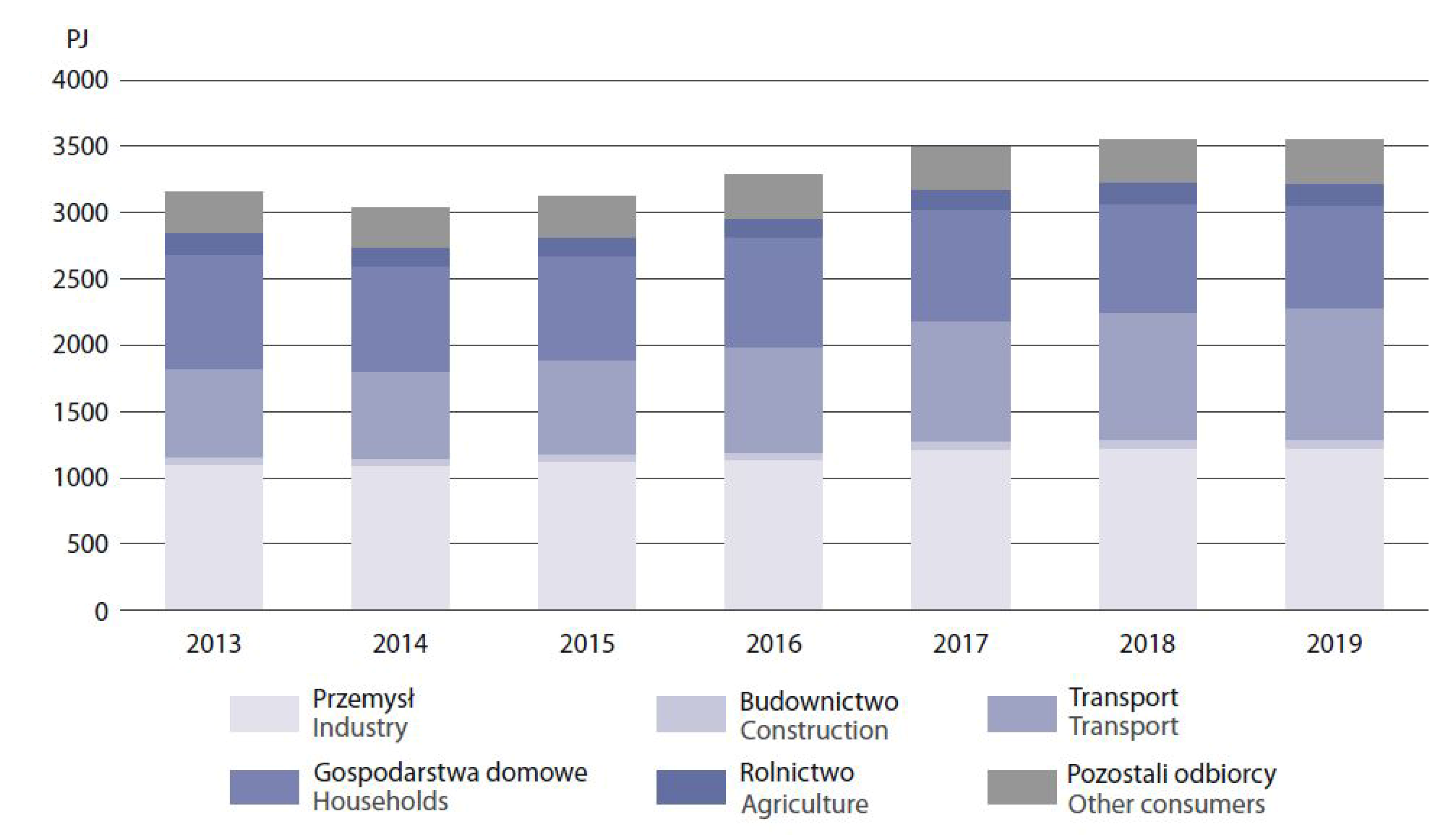
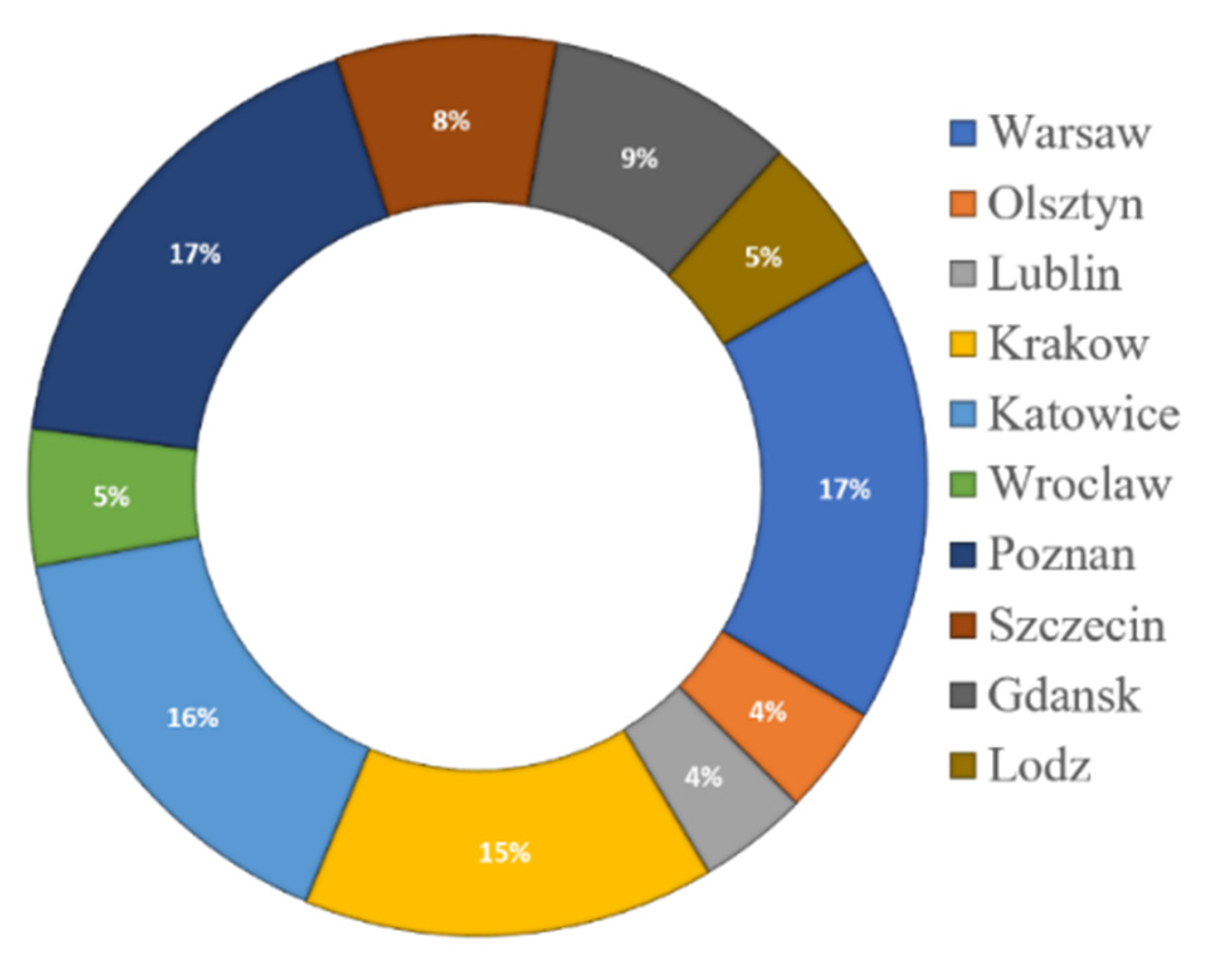

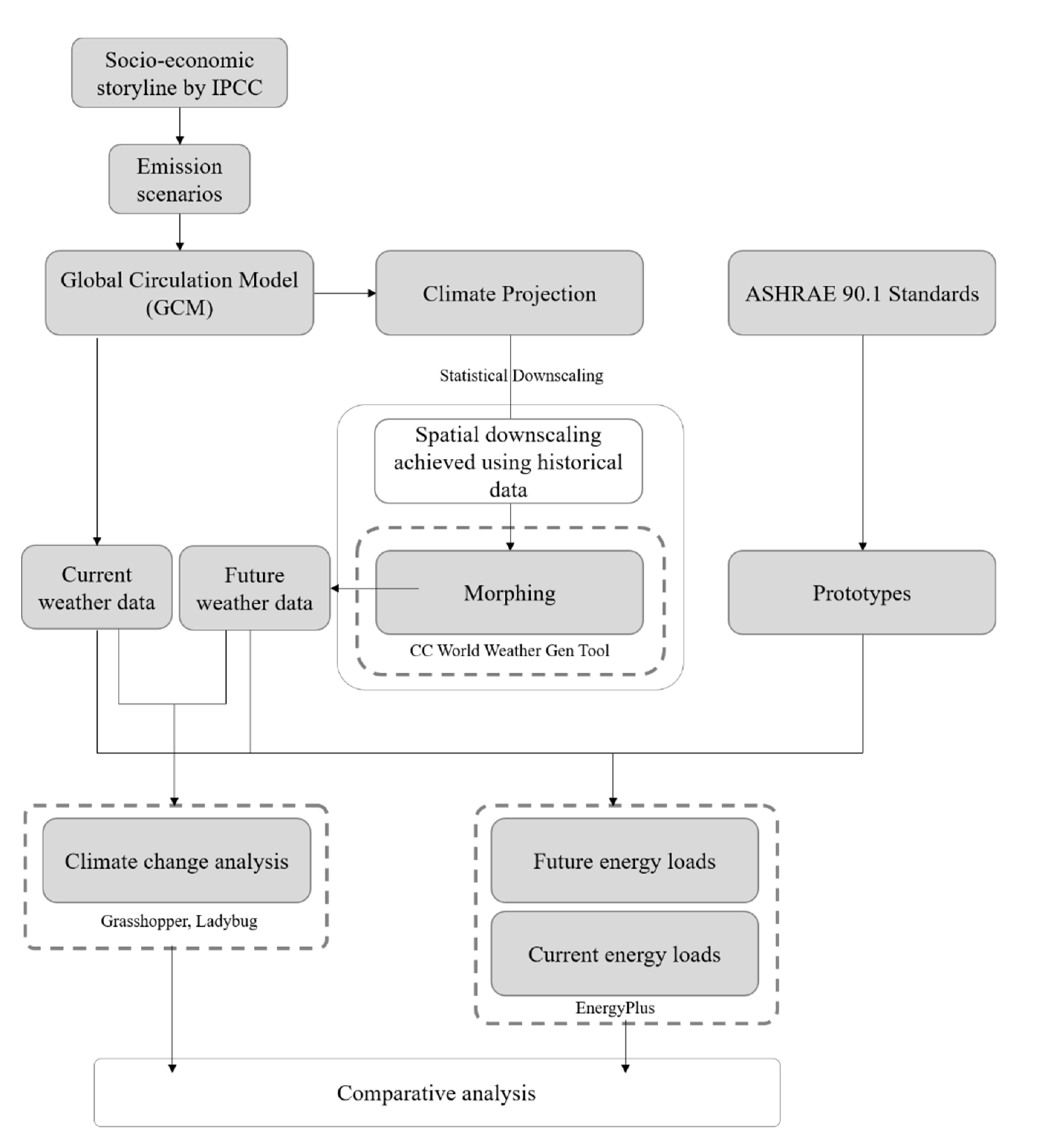

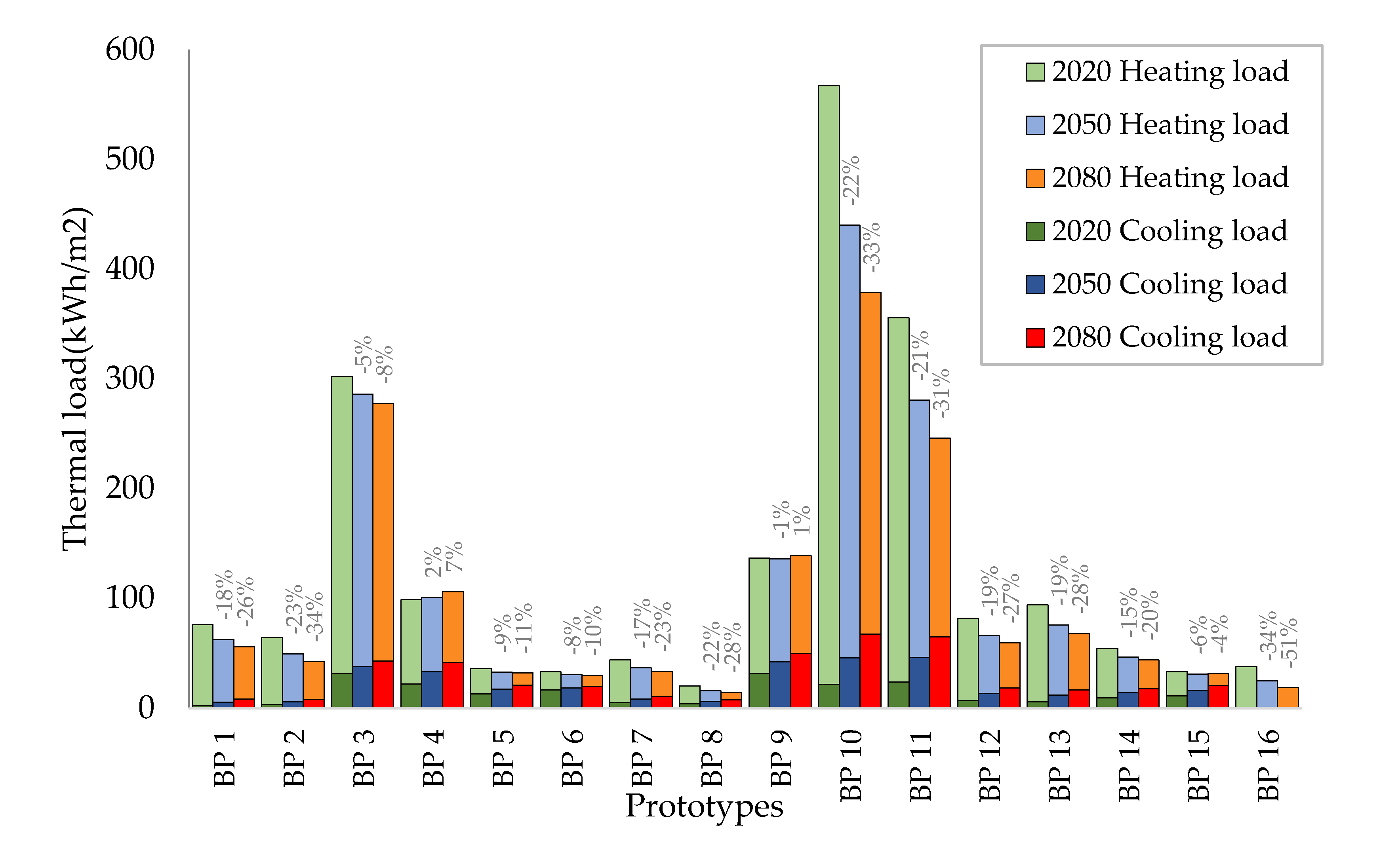
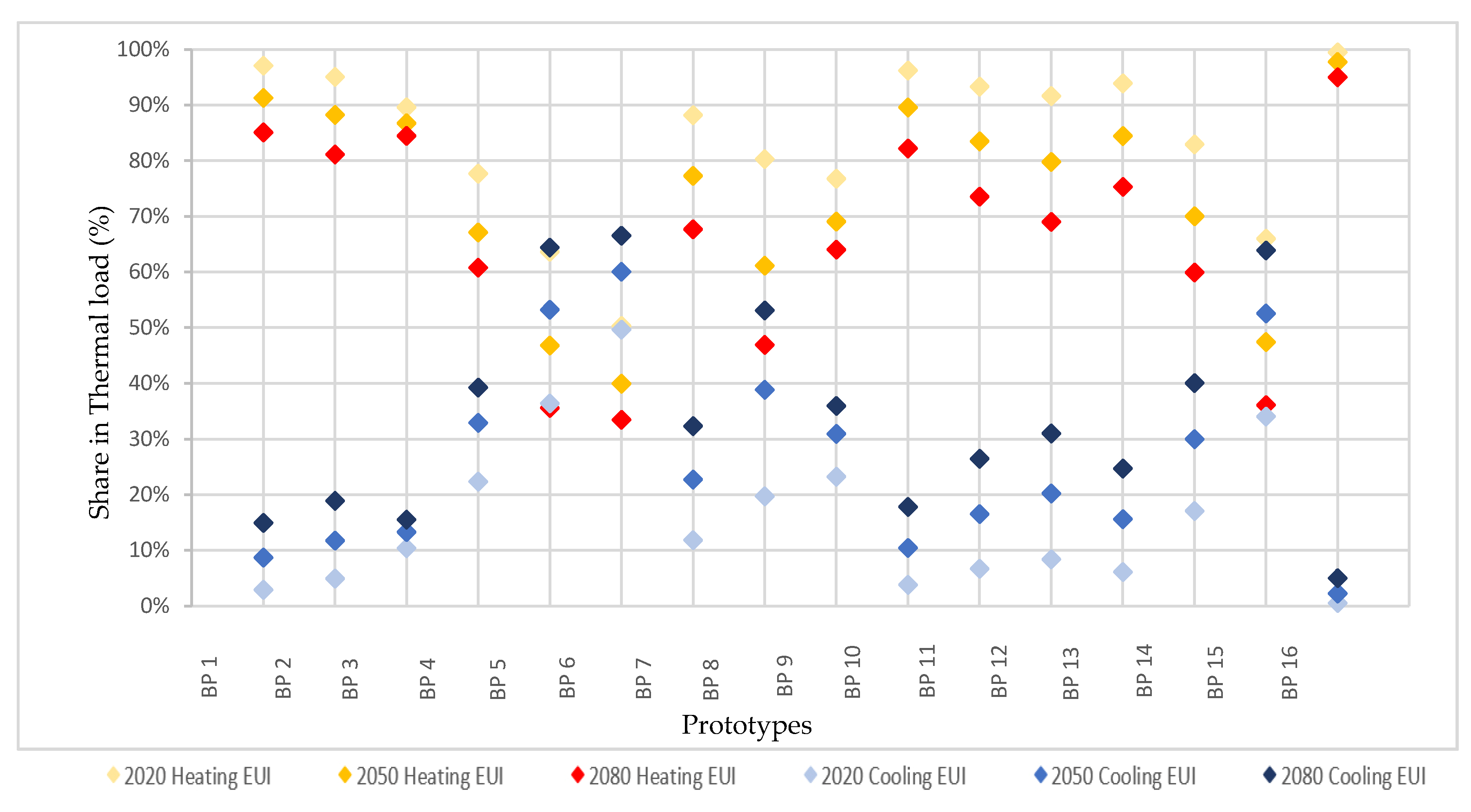
| Country | City | Latitude | Longitude | Time Zone | KGC |
|---|---|---|---|---|---|
| Poland | Poznan | 52.42N | 16.83E | 1.00 | Cfb |
| Population | Elevation | Weather Data | Heating DB 99.6% | Cooling DB 0.4% | Cooling 0.4% MCWB |
| 533,830 | 302 (m) | 2004–2018 (TMY) | −14.27 °C | 29.77 °C | 19.22 °C |
| Location | Jan | Feb | Mar | Apr | May | Jun | Jul | Aug | Sep | Oct | Nov | Dec |
|---|---|---|---|---|---|---|---|---|---|---|---|---|
| Ławica Airport | 2016 | 2017 | 2009 | 2005 | 2007 | 2005 | 2013 | 2017 | 2015 | 2008 | 2012 | 2014 |
| Building Types | U-Factor (W/m2K) | Solar Heat Gain Coefficient (SHGC) | |||||
|---|---|---|---|---|---|---|---|
| Roof | External Wall | Glazing | Glazing | ||||
| Window | Skylight | Window | Window | ||||
| Apartment | High-rise (BP1) | 0.18 | 0.31 | 2.65 | - | 0.43 | - |
| Mid-rise (BP2) | 0.18 | 0.31 | ti2.65 | - | 0.43 | - | |
| Hotel | Large (BP4) | 0.18 | 0.45, 0.51 | 2.65 | - | 0.43 | - |
| Small (BP5) | 0.18 | 0.31 | 2.65, 2.85 | - | 0.43, 0.29 | - | |
| Office | Large (BP6) | 0.18 | 0.51 | 2.65 | - | 0.43 | - |
| Medium (BP7) | 0.18 | 0.31 | 2.65 | - | 0.43 | - | |
| Small (BP8) | 0.15 | 0.29 | 2.65 | - | 0.43 | - | |
| Health | Hospital (BP3) | 0.18 | 0.45, 0.51 | 2.65 | - | 0.43 | - |
| Outpatient (BP9) | 0.18 | 0.31 | 2.65 | - | 0.43 | - | |
| Restaurant | Fast food (BP10) | 0.15 | 0.29 | 2.65 | - | 0.43 | - |
| Sit-down (BP11) | 0.15 | 0.31 | 2.65 | - | 0.43 | - | |
| Retail | Stand-alone (BP12) | 0.18 | 0.51 | 2.65 | 2.96 | 0.43 | 0.34 |
| Strip-mall (BP13) | 0.18 | 0.31 | 2.65 | - | 0.43 | - | |
| School | Primary (BP14) | 0.18 | 0.31 | 2.65 | - | 0.43 | - |
| Secondary (BP15) | 0.18 | 0.31 | 2.65 | 2.96 | 0.43 | 0.34 | |
| Warehouse | (BP16) | 0.21, 0.53 | 0.28, 0.47 | 2.65 | 2.96 | 0.43 | 0.34 |
| Weather Parameters | 2020 | 2050 | 2080 |
|---|---|---|---|
| Dew point temperature (°C) | 4.2 | 6.0 | 7.2 |
| Average ground temperature (°C) | 8.0 | 10.8 | 12.6 |
| Dry bulb temperature (°C) | 8.2 | 10.9 | 12.6 |
| Direct normal radiation (Wh/m2) | 59.1 | 81.3 | 86.4 |
| Diffuse horizontal radiation (Wh/m2) | 75.9 | 72.5 | 71.4 |
| Global horizontal radiation (Wh/m2) | 109.7 | 113.0 | 115.7 |
| Horizontal infrared radiation (Wh/m2) | 303.0 | 322.1 | 331.5 |
| Direct normal illuminance (lux) | 7015 | 7385 | 7875 |
| Diffuse horizontal illuminance (lux) | 8578.5 | 8609.7 | 8527.7 |
| Global horizontal illuminance (lux) | 12,157 | 12,434 | 12,739 |
| Atmospheric pressure (Pa) | 101,325 | 101,272 | 102,249 |
| Relative humidity (%) | 78.1 | 74.6 | 72.7 |
| Total sky cover (0–10) | 4.5 | 4.2 | 4.3 |
Publisher’s Note: MDPI stays neutral with regard to jurisdictional claims in published maps and institutional affiliations. |
© 2021 by the authors. Licensee MDPI, Basel, Switzerland. This article is an open access article distributed under the terms and conditions of the Creative Commons Attribution (CC BY) license (https://creativecommons.org/licenses/by/4.0/).
Share and Cite
Bazazzadeh, H.; Pilechiha, P.; Nadolny, A.; Mahdavinejad, M.; Hashemi safaei, S.s. The Impact Assessment of Climate Change on Building Energy Consumption in Poland. Energies 2021, 14, 4084. https://doi.org/10.3390/en14144084
Bazazzadeh H, Pilechiha P, Nadolny A, Mahdavinejad M, Hashemi safaei Ss. The Impact Assessment of Climate Change on Building Energy Consumption in Poland. Energies. 2021; 14(14):4084. https://doi.org/10.3390/en14144084
Chicago/Turabian StyleBazazzadeh, Hassan, Peiman Pilechiha, Adam Nadolny, Mohammadjavad Mahdavinejad, and Seyedeh sara Hashemi safaei. 2021. "The Impact Assessment of Climate Change on Building Energy Consumption in Poland" Energies 14, no. 14: 4084. https://doi.org/10.3390/en14144084
APA StyleBazazzadeh, H., Pilechiha, P., Nadolny, A., Mahdavinejad, M., & Hashemi safaei, S. s. (2021). The Impact Assessment of Climate Change on Building Energy Consumption in Poland. Energies, 14(14), 4084. https://doi.org/10.3390/en14144084








